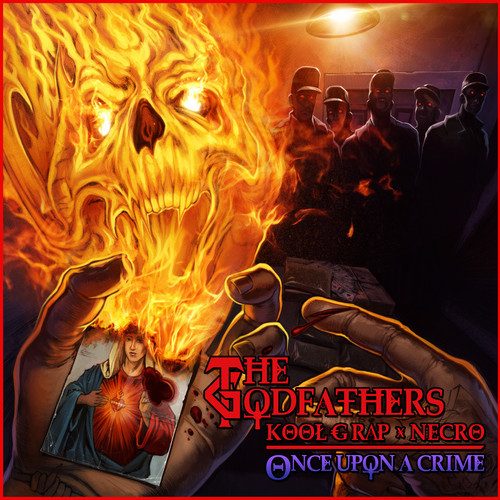As far back as I can remember, Necro always wanted to be Kool G Rap. G Rap’s influence on the art of rap is immeasurable, but no one mimicked the pitch, the metrics, the attitude, even the lisp of the Golden Age great to the degree of Ron Braunstein. And yet he has, with Necro, created a character virtually second to none in rap music. Strictly sticking to the dreadful side of human nature, Necro has established himself as the foremost pulp rapper. He’s made some interesting songs in the process, but his body of work is literally battered and bruised, leaving behind one long trail of blood. Despite this blunt characterization, Necro is also a successful DIY artist, which puts him in the position of being able to offer his idol a joint record. It’s a shrewd way to align himself with rap royalty but an opportunity he doesn’t quite seize.
On one specific level “Once Upon a Crime” makes sense like few collaboration projects. For twenty plus years, Kool G Rap has interpreted the role of hard-boiled underworld figure with unique consistency. He doesn’t flinch when it comes to depicting the gory details, and neither does Necro. The reason they have different aesthetics (and ultimately artistic standards) lies in the fact that they have chosen different genres. Cinematographically speaking, the master has specialized in mob and gangster flicks, the apprentice in horror and splatter movies. Their common ground is obviously violence, but what truly makes them brothers in arms is their thoroughly graphic approach. Both are experts at visualizing their threats and boasts, which lends some authenticity to even the most outlandish claims. Where most rappers drop references in a rather random manner, these two do not just have a vague understanding of what they’re talking about. Serial killers, mob figures, anatomical details, etc. are all put to proper use lyrically. Heeding the call of the rhyme, they’re also very keen to find all kinds of creative combinations of slang words and street terms.
More than once The Godfathers go above what you could call their lowest common denominator – elaborate depictions of brute force. “Crook Catastrophe & The Gunblast Kid” sees both rappers committing fully to the western theme, resulting in a standout track. Necro talks twice on the subject of snitches like he was a gangsta rap vet:
“You’re a government witness, no recovery for that sickness
Just discovery of your ligaments in shipments
to the District Attorney’s office of business
Crooked officers’ll off you when I insist”
Meanwhile Giancana peers over the edge of sanity in “The Pain” and “Unsub,” making himself at least temporarily at home in Necro’s dirty dungeon:
“I’m Charlie Manson on Harleys glancin’ at Hollis mansions
Catch couples in parks be lampin’ in RV’s campin’
Watchin’ your bitch undress down to the bra, me pantin’
What I do when I start advancin’ is hardly handsome”
If Kool G Rap can feel flattered by Necro’s career-long imitation, vice versa the Queens vet shows himself to be open to suggestions from the Brooklyn rep, at one point openly acknowledging their kinship: “We might bring it from different angles, but the same breed / Movie shit, you pay rental fees to hang with G.” Necro’s expenses to hang with G aren’t really relevant as they are both determined to emerge as The Godfathers, whether with songs that are set in organized crime, or others, like the creepy “Wolf Eyes,” which features the album’s only guest, Mr. Hyde.
Ultimately “Once Upon a Crime” gives us exactly what we can realistically expect from it. Necro is a heavy worker in every respect, including his head-on and hands-on approach to rapping and production. “Once Upon a Crime” is a bonafide b-movie down to the fact that Necro handles several tasks at once. As a producer, he makes sure the music is varied, but it almost always has that if not formulaic then still strictly functional appeal. As a rapper, he puts evident effort into rhyme scheme and word association, but he belts out all his bars in the same bellicose bark, overpowering eventual undertones in the production. Whose finer points certainly don’t include the rhythm section with its mostly bland drum sounds and basslines.
In a perfect world, the one going the distance with Kool G Rap would be AZ, and they’d have a squad of superproducers backing them. Or Necro would channel his energy exclusively into beats. Or The Godfathers would have come up with a bulletproof storyline to bring some degree of organization to their operations. Or “Once Upon a Crime” would signal nothing short of a rebirth of New York street rap. Instead you get expertedly done genre music that has exploitative written all over it. Yet despite some fundamental flaws “Once Upon a Crime” is a record hip-hop can be proud of, one that represents the part of the family with ties to the underworld (and sometimes the afterworld) with aplomb.

